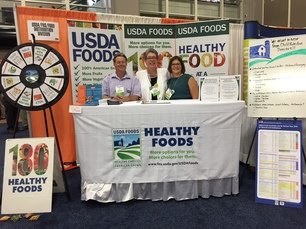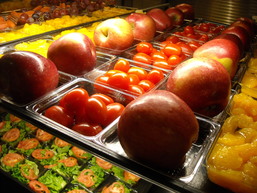|
What's Shaking?
USDA’s Team Nutrition is pleased
to announce the release of a brand new infographic for school nutrition
professionals. Schools are making great strides in serving healthy meals with
less sodium to children across the nation. Click here to see the
infographic, and please share with other school nutrition professionals who are
making a difference in helping children adopt healthy habits.
The What’s Shaking? Creative Ways to Boost Flavor with Less Sodium, website provides a convenient, audience-specific hub for schools and other
communities to access various resources on sodium reduction and healthier
school meals. For more information on What’s
Shaking? visit: http://healthymeals.nal.usda.gov/whatsshaking.

 School Nutrition Association’s Annual National Convention Recap
USDA Foods presence was prominent in USDA Lane at the School Nutrition Association Annual
National Convention (SNA ANC) Salt Lake City Exhibit hall this year. Exhibit participants
were able to sign up for the new USDA Foods e-letter for schools, review
the Foods Available List and talk to subject matter experts from the Food and Nutrition Service and the Agricultural Marketing Service. There was also a USDA Foods survey on prospective new foods. In addition, Food Distribution
staff presented in several sessions; What’s New with USDA Foods, Maximizing
USDA Foods in Your Breakfast, Supper & Summer Meal Programs, Roundtable
Session, and Getting the Biggest Bang for your USDA Foods Buck. Hope you will
be able to join us in USDA Lane in San Antonio, TX at SNA ANC 2016!
|

FNS Staff Visit High School Cafeteria
Before the school year drew to a close, FNS staff ventured down
the street to T.C. Williams High School in Alexandria, Virginia. Cindy Hormel,
Director of School Nutrition Services for Alexandria City Public Schools, led a
tour of the cafeteria and kitchen facilities that produce 1,600 meals per day.
Hormel, who began her tenure in fall 2014, explained her efforts to
increase participation in the school lunch program and provide quality,
nutritious meals. Incidentally, T.C. Williams is the home of the 1971 state
championship football team featured in the 2000 film "Remember the
Titans," and Titan mascot pride still adorns the cafeteria and campus
halls.
|

FNS staff then had the opportunity to scout
out the food options and assemble their own reimbursable meals. Each
day, themed lunch lines include the Titan Grille, Manhattan Deli,
International Marketplace, Café Del Sol, and Just Pizza. Popular USDA
Foods products include chicken, ground beef, DoD Fresh produce, peanut butter,
and pizza using the cheese rebate. The school district is 61% eligible for free and
reduced lunch, and some campuses offer supper, breakfast in the classroom, or
universal breakfast. In addition to expanding access to meals during the school
year and the summer, Hormel's goal is to increase nutrition education in
the cafeteria and classrooms. Hopefully, the Titans will remember to make
half their lunch tray fruits and vegetables!
|

Dark Green
and Delicious: The Story of USDA Foods Frozen Broccoli
When the
meal pattern changes went into effect for school meals, many States and school
districts contacted USDA Foods to request additional dark green vegetable
options. USDA responded by surveying
school districts to determine which options they would be the most interested
in and then contacting growers and processors to determine the current domestic
availability of these products. Broccoli
was a high priority for schools and had multiple sources of domestic
production, so USDA launched the process to add frozen broccoli to the Foods
Available List for SY12-13. Since it was
introduced, this product has been extremely popular and USDA has received positive
feedback from many States and school districts about the quality and
versatility of this item.
As with any USDA Foods product, the work does not stop after the
product is introduced. It is important for our Agricultural Marketing
Service (AMS) partners to maintain relationships with vendors and growers so
that our recipients continue to receive a high quality product when they need it and growers can anticipate recipient needs and be prepared to support
them. As part of this continuous learning and communication process,
staff from USDA recently visited two broccoli growers in Central California to
talk about purchases for the National School Lunch Program. This was an
opportunity to discuss the market conditions and future demand, as well as
listen to suggestions about how to better synchronize purchases with the
growing cycles. Staff was able to see broccoli production from the field
to the package with a tour that ranged from viewing the fields of freshly
planted broccoli to harvesting, hand-trimming, blanching, quick-freezing, and
packaging. Staff even got a chance to taste some broccoli fresh from the
field!
This behind-the-scenes work helps USDA to ensure a more reliable
and efficient USDA Foods supply chain and is just one example of the work we do
daily to support schools in serving high quality, nutritious, American-grown
foods.
|


High-protein (Greek-style) Yogurt Available to All Interested States
Protein products are
consistently among the most popular items available to schools through the USDA
Foods program. After two years of pilot testing, USDA has expanded the availability
of the high-protein (Greek-style) yogurt to all interested States in SY 2015-2016!
High-protein yogurt provides an additional meat/meat alternate (USDA
Foods Fact Sheet) option for schools, while also being a great source of
protein and calcium for students.
USDA initially selected four
States to take part in the yogurt pilot during SY 2013-2014. Additional
states were added to the pilot in SY 2014-2015, for a total of twelve States during
the second year. Participating states included Arizona, California,
Connecticut, Idaho, Illinois, Iowa, Mississippi, New York, North Carolina,
Tennessee, Vermont, and Washington.
During the spring of 2015, USDA surveyed school districts
that participated in the pilot. Districts consistently received positive
responses about the overall acceptability of the high-protein yogurt options
available through USDA Foods. USDA also reviewed State feedback to ensure that
States could effectively distribute high-protein yogurt using a variety of
distribution models and geographic distances. Because high-protein yogurt is a
refrigerated product with a relatively, short shelf-life, States need to use
different ordering and distribution practices than they may use for other USDA
Foods options.
States and school districts can choose among 4 ounce cups,
available in vanilla, strawberry, and blueberry flavors, and 32 ounce tubs,
available in plain and vanilla. All available options are reflected on the USDA
Foods Available List for Schools. Product information is available on the USDA
Foods Available List.
USDA has made ordering and delivery schedules for
SY2015-2016 available to States. School districts who are interested in USDA
Foods high protein yogurt options should contact the appropriate State
Distributing Agency.
|
 The Importance
of Destination Information
USDA contracts with vendors to
deliver the foods offered through WBSCM. Purchase orders placed online
constitute part of the contractual agreement with these vendors. After a
purchase order is awarded, unanticipated changes to the destination address or
contact information initiate a process of contract modification, which consumes
considerable time and administrative resources for everyone involved.
Understandably, some changes
cannot be foreseen or executed before a contract is awarded. To allow
sufficient time to make and communicate modifications, the following are
recommended best practices for States (SDAs) and Recipient Agencies (RAs), if
applicable:
- Review orders in process to ensure the correct destination
is identified.
- Communicate destination changes at least 45 days prior
to the start of the delivery period. For example, destinations
changes for the September 16 – 30 delivery window should be received by August
1.
In the event a SDA needs to add
a new destination or modify the existing contact information, FNS has set up a
central e-mail address for updates to Ship-to information: WBSCM-Ship-To@fns.usda.gov.
Please note this address is for management of the master list of destinations
and not for changes to destinations on orders.
For more information about
USDA’s contract award dates for each school year, States and RAs are invited to
review documentation published on the AMS Commodity Purchasing website: http://www.ams.usda.gov/AMSv1.0/commoditypurchasing.
Solicitations are generally issued 30 days in advance of the anticipated award
date or about 90 days prior to the start of the delivery period.
|
School Year 16 Entitlement Rate Announced
Earlier this month, the School Year 16 (SY16) entitlement rate was published in the Federal Register. The SY16 rate will decrease by one cent from 24.75 cents in SY15 to 23.75 cents in SY16. The annual adjustment that occurs each year reflects changes in a three-month average value of the Producer Price Index for Foods Used in Schools and Institutions for March, April, and May each year (Price Index). The Price Index is computed using five major food components (cereal and bakery products; meats, poultry, and fish; dairy; processed fruits and vegetables; and fats and oils), and each component is weighted using the relative weight as determined by the Bureau of Labor Statistics. The decrease in the SY16 rate was due to a drop in average prices for three of the five categories in the Price Index. The dairy and fats and oils categories dropped most significantly.
Despite a drop in the donated foods per meal value in SY 2016, the overall donated foods entitlement amount schools receive will likely increase slightly in SY 2016 with the funds provided through the 12% provision. By law, the overall USDA Foods entitlement amount each school receives must not be less than 12% of the total value of expenditures supporting the National School Lunch Program. The donated foods entitlement amount is monitored through the school year and adjusted, if necessary, to meet the 12% requirement.
 Connecticut’s Direct Delivery Pilot
Challenges of the short shelf life associated with the USDA
Foods high protein yogurt pilot, compelled Connecticut's Food Distribution Director to
consider alternate delivery options outside of the State’s traditional State contracted
warehouse. Once-per-month deliveries through the State contracted warehouse
would not allow school districts to receive and utilize the yogurt before its
best-if-used-by date. Because the school districts could order as little as 2
pallets of yogurt, they were able to accommodate direct deliveries. School
districts that couldn’t accommodate direct deliveries had their yogurt
delivered to their chosen distributors weekly. The success
of this pilot convinced CT to consider this delivery method for other USDA
Foods.
The State implemented a direct delivery pilot with the 7
original school districts that participated in the yogurt pilot. These districts will receive their USDA Food deliveries either directly to their school facilities
or to their chosen distributor. With the assistance of the State, school
districts order according to number of cases/pallet sizes. The State’s
experience with typical USDA Foods vendors helps them to calculate pallet sizes
and number of cases.
This pilot will allow school districts to avoid case fees
associated with the State contracted warehouse, receive weekly or direct
deliveries, and avoid the 30-45 day delay associated with deliveries made from the State- contracted
warehouse.
Although the State will forego the per case administrative
fee, the State will also spend fewer resources inspecting and conducting
physical inventories at the State contracted warehouse, reducing their overall
program costs.
|
 What two reasons does the 1946 National Lunch Act preamble cite as the reasons for establishing the National School Lunch Program?
The National School Lunch Program was established as a matter of national security, to:
1- Safeguard the health and wellbeing of the nation’s children and
2- Expand the market with nutritious (domestic) agricultural commodities.
|

On August 13, 2015, USDA’s Agricultural
Marketing Service will host a webinar on USDA's Pilot Project for the Procurement
of Unprocessed Fruits and Vegetables to provide details on how to become a
vendor. During this webinar you will learn:
- Vendor Eligibility Requirements, the Application
Submission process, and how contracts and payments to vendors are made.
- How the Pilot Project leverages participating school’s
established relationships with growers, produce wholesalers, and
distributors while encouraging new partnerships.
- The roles of Federal, State, and local agencies and
various distribution scenarios.
The Pilot helps schools in eight states (California, Washington,
Oregon, Michigan, Wisconsin Connecticut, New York and Virginia) promote “local”
purchases and farm-to-school initiatives. Click here to register today!
|
2015 USDA/State Agency Meeting
This years USDA/State Agency meeting will take place November 2-5, 2015 in Crystal City, Virginia. This meeting is open to USDA and State Agency Partners only.
This gathering will focus on issues of strategic importance for USDA and State Child Nutrition leadership. It will also offer updates on further implementation of the Healthy, Hunger-Free Kids Act (HHFKA) of 2010, address State concerns and questions, and highlight best practices. Further, it will feature information on integrity, school food authority compliance and expectations of State agencies while conducting administrative review.
If you have any questions, please contact your Food and Nutrition Service Regional Office.
|